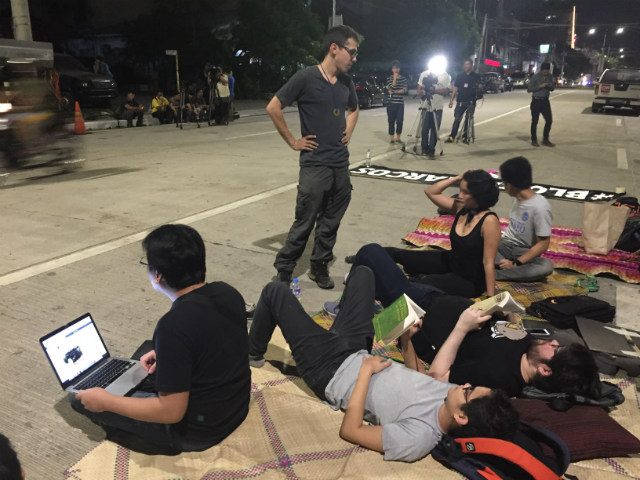SUMMARY
This is AI generated summarization, which may have errors. For context, always refer to the full article.

MANILA, Philippines – Holding books, smartphones, and laptops while seated on picnic mats, millennials gathered outside the Libingan ng mga Bayani (Heroes’ Cemetery) on Tuesday evening, November 29, to protest against the hero’s burial for dictator Ferdinand Marcos.
While they had chants here and there, most of their time was spent listening to older men and women recounting the horrors of martial law at past 8 pm on Tuesday.
At the start of their event, at around 7 pm, it even looked like a group meeting for a class project, with around a dozen of them sharing their feelings and thoughts about the hero’s burial for Marcos.
Like a group meeting for school. Block #Marcos group, composed of millennials who met via social media, planning next moves @rapplerdotcom pic.twitter.com/qLcHwu01gA
— Paterno Esmaquel II (@paterno_II) November 29, 2016
Their vigil on Tuesday stood out not because of the number of participants or the loudness of their chants.
After all, it was smaller than the usual rallies – only around 50 people were there as of 9 pm. And their classroom-like set-up was so peaceful, the 70 policemen assigned to watch them had been left with almost nothing to do.
Their vigil on Tuesday stood out because members of the group, called Block Marcos, said many of them met only on Facebook.
It was one of the signs of the times – a protest led by students and young professionals prompted by posts on social media.
Kat Leuch, a 31-year-old law student, is the spokesman of Block Marcos. Leuch said they’re not all classmates, schoolmates, or officemates.
“Nagkakila-kilala kami through social media at sa mga events practically na na-organize, na ipinanawagan sa social media,” Leuch told Rappler.
(We got to know each other through social media and events that were practically organized and announced through social media.)
WATCH: Members of “Block Marcos,” millennials who met via social media, discuss their modern-day anti-#Marcos protest @rapplerdotcom pic.twitter.com/CklO0AUJjy
— Paterno Esmaquel II (@paterno_II) November 29, 2016
How social media helped
Michael Santos, 34, who works at a business process outsourcing company, said Tuesday was his first time to meet other members of Block Marcos.
Santos, however, said he already saw his fellow members in other rallies and protests before.
“Sinundan ko sila doon sa Block Marcos page, then doon na lang ako naghihintay ng mga updates, then kung saan ‘yung mga protest, pumupunta na lang ako doon,” Santos said.
(I followed them on the Block Marcos page, then it’s there that I wait for updates, then wherever the protests are, I just go there.)
Milky Babilonia, a 22-year-old worker for a non-governmental organization, said he is “happy” to have met his fellow Block Marcos members “online and in other movements.”
Babilonia said he met Leuch, for instance, at a noise barrage.
He said, “We just recognized, ‘O, ‘di ba ikaw ‘yung nag-comment doon sa post ko?” (We just recognized each other, ‘Oh, weren’t you the one who commented on my post?)
Babilonia said: “So I think if you’re asking me how social media helped, I think it’s through the easy exchange of information, and we validate that given our own judgment with legitimate news and real news online that we see, not the fake ones.”
Aside from listening to mini-lectures on martial law, participants at the vigil also lit candles and tied black ribbons around the fence of the Libingan ng mga Bayani – a sign of the millennials’ burgeoning protest movement. (READ: Students at anti-Marcos rally: We’re part of the fight)
WATCH: Anti-Marcos group Block Marcos tying black ribbons around the fence of the Libingan ng mga Bayani @rapplerdotcom #AntiMarcosRally pic.twitter.com/EC5QJdWpsF
— Paterno Esmaquel II (@paterno_II) November 29, 2016
WATCH: Anti-Marcos group Block Marcos also lighting candles outside Libingan ng mga Bayani @rapplerdotcom #AntiMarcosRally pic.twitter.com/RZl4tB91SO
— Paterno Esmaquel II (@paterno_II) November 29, 2016
The millennials here plan to stay until Wednesday morning, November 30, when protesters stage a third round of huge anti-Marcos rallies across the Philippines. (READ: Schedule: November 30 rallies vs Marcos) – Rappler.com
Add a comment
How does this make you feel?
There are no comments yet. Add your comment to start the conversation.